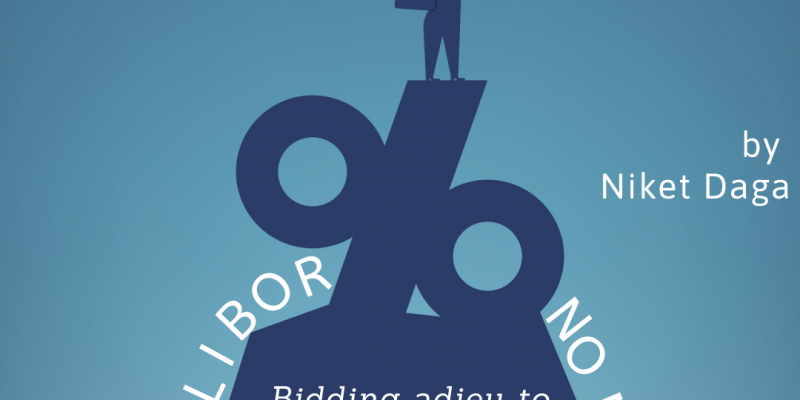LIBOR: No More


Niket Daga
The London Inter-Bank Offer Rate or LIBOR is on its way to vanishing from the worldwide debt market following an order by the UK’s Financial Conduct Authority. The FCA announced that LIBOR currently controlled by the Intercontinental Exchange (ICE) Benchmark Administration shall cease to be used from 31 December 2021. This announcement added pressure on market participants to complete their transition plans by the end of 2021.
Loans can be acquired at both fixed interest rates as well as at floating interest rates that periodically adjust as per interest rate market conditions. The change in interest rate with a variable rate loan is often based on a reference, or “benchmark”, that is outside the parties’ control. LIBOR, the base of the floating-rate market since the 1980s, “the most important number” as it was called by the market participants, will be dying soon. The most used rate of the debt market, LIBOR, is the rate at which large banks are “willing” to borrow from one another in the wholesale funding market in a specific currency for a specific maturity. The rate is calculated daily based on estimates from a panel of 15-20 institutions for each currency. It is a global benchmark that is used across major currencies and markets to calculate interest rates for a wide range of financial instruments, from variable-rate mortgages to trillions of dollars worth of derivatives contracts.
To hide the crisis for cash in 2008, big banks started to play with LIBOR. Since the LIBOR was dependent on the rates given by the banks, they leveraged this mechanism in an unfair manner. 2008 saw the lack of liquidity in the global markets and hence the rates on short-term loans soared. The big banks did not want to report the high-interest rates offered on short term loans, avoiding the market with a tip of desperation for cash. This game went on intensifying until 2012 when the Commodity Futures Trading Commission (CFTC) caught and fined major banks including Barclays, UBS, Deutsche Bank and others that were influencing the rates to benefit their LIBOR contracts. This was when the strength of LIBOR turned into weakness: the virtue of being market-dependent. Over time now it has become clear that the benchmark rate has lost its reliability and originality.
The figurehead of all interest rates worldwide had to be dismissed from operations. A close analogy to this would be eliminating salt from the culinary world, leaving it tasteless. The rate that had contracts worth more than $300 trillion attached to it was on the verge of demise. But this transition was never meant to be easy. The world needed an alternative to replace the LIBOR contracts that existed in the markets. Not only a substitute rate was needed to be defined but also the conversion rates needed to be put in place to replace LIBOR. The foundation stone of LIBOR’s farewell had been laid back in 2014 and for the past 8 years, regulators all across the globe are in search of a possible replacement for LIBOR.

In the hunt for the best, The Alternative Reference Rates Committee (ARRC) in the U.S.came up with a Secured Overnight Financing Rate (“SOFR”) as the alternative to LIBOR. SOFR is an overnight repo rate, the rate at which large institutions borrow money in the overnight lending market backed by the collateral of the U.S. treasury. This gives an implication of SOFR being a risk-free rate, as opposed to LIBOR which reflects the banking sector’s credit risks. Furthermore, SOFR only provides the rate for overnight maturity, whereas LIBOR provides a range of maturities. Because of these distinctions, it is not viable to simply substitute SOFR for LIBOR in existing contracts. Adjustments are a must before SOFR could be replaced as the benchmark rate. A premium must be attached to SOFR, but credit risk premium and term premium are factors that cannot attract complete agreement in terms of value. Let’s assume that the three-month LIBOR rate, expressed as an annual percentage, stands at 2.49%, and SOFR equals 2.69%. To arrive at the current rate for a traditional 30-year mortgage of 4.875%, an institution would need to add 2.385% to LIBOR and 2.185% to SOFR. While the end rate is the same, the risk premium differs.
This incident will cast a considerable impact on the working of the entire financial system. Differences in the rates will lead to dissimilarities in valuation, particularly for interest rate swaps and derivatives. Investors with large swap books will have to carefully manage this risk and build operational and trading capabilities for SOFR-linked derivatives products. In addition to this, for the corporates, the fallback provision system will also die. For example, the fallback condition in one of Apple’s floating-rate note contracts stipulates that if the LIBOR benchmark is not available, the rates will be determined based on bids provided by four key reference banks in the LIBOR market. However, if the LIBOR market fails to exist, such a law may result in a great deal of ambiguity and legal challenges from investors.
Though SOFR is hard to manipulate, the involvement of the real-market transactions, any volatility in the economy and the market for repurchase agreements could result in SOFR fluctuations. This could create a highly volatile SOFR market affecting the consumer interest rates adversely. The increased use of SOFR can only be the answer to this. Worst-case scenario, this replacement might lead to a situation that could have a harsh impact on the banking sector, if they are not able to manage the switch while keeping the balance sheet risk in check. The regulators need to keep an eye on the smooth transition or else it will lead to a massive rupture in the financial system. LIBOR’s downfall appears to be a foregone conclusion. However, the risks that come with it are still unknown. Preparing ahead of time is the best strategy to deal with an event with an unpredictable outcome.